What Is The Main Phyla Or Divisions For Plante In The Animal Kingdom
Table of Contents
- Plant Kingdom – Members of Kingdom Plantae
- Characteristics of Kingdom Plantae
- Classification of Kingdom Plantae
- Cryptogams and Phanerogams
Plant Kingdom – Members of Kingdom Plantae
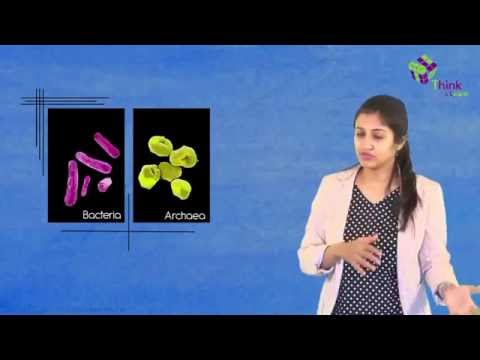
R.H. Whittaker gave the Five Kingdom classification for living organisms. He categorized living organisms based on multiple characteristics such as cellular structure, mode of nutrition, body organisation, reproduction, phylogenetic relationship, etc. These v kingdoms were Monera, Protista, Fungi, Plantae and Animalia.
Let's learn about the plant kingdom, i.e., Kingdom Plantae.
Let the states have a detailed look at the plant kingdom notes provided here for the conceptual understanding of the topic.
Also read:Kingdom Animalia, Plantae And Viruses
Found Kingdom – Plantae
Kingdom Plantae includes all the plants. They are eukaryotic, multicellular and autotrophic organisms. The plant cell contains a rigidcell wall. Plants accept chloroplast and chlorophyll pigment, which is required for photosynthesis.
Characteristics of Kingdom Plantae
The establish kingdom has the following feature features:
- They are non-motile.
- They brand their own food and hence are called autotrophs.
- They reproduce asexually by vegetative propagation or sexually.
- These are multicellular eukaryotes. The establish jail cell contains the outer cell wall and a big central vacuole.
- Plants contain photosynthetic pigments called chlorophyll nowadays in the plastids.
- They have different organelles for anchorage, reproduction, support and photosynthesis.
Explore More:Photosynthesis.
Recommended Video:

Classification of Kingdom Plantae
A plant kingdom is further classified into subgroups. Classification is based on the following criteria:
- Establish body: Presence or absence of a well-differentiated plant body. E.g. Root, Stalk and Leaves.
- Vascular system: Presence or absence of a vascular system for the transportation of water and other substances. East.g. Phloem and Xylem.
- Seed formation: Presence or absence of flowers and seeds and if the seeds are naked or enclosed in a fruit.
More than to Read: Seed And Fruit Formation – Seed Dispersal
The found kingdom has been classified into five subgroups co-ordinate to the above-mentioned criteria:
- Thallophyta
- Bryophyta
- Pteridophyta
- Gymnosperms
- Angiosperms
Thallophyta
Thallophytes lack a well-differentiated body structure and the plant body is thallus like.
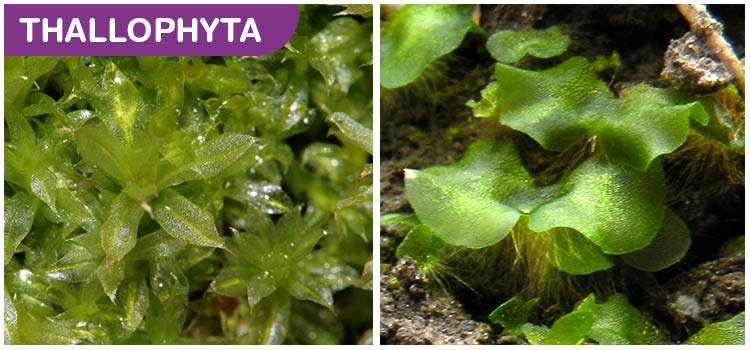
Thallophytes: Primitive plants where the trunk is non differentiated into stem, roots and leaves
Thallophyta includes plants with archaic and simple body structures. The found torso is thallus, they may be filamentous, colonial, branched or unbranched. Examples include light-green algae, red algae and brownish algae. Mutual examples are Volvox, Fucus, Spirogyra, Chara, Polysiphonia, Ulothrix, etc.
Explore More than:Thallophytes
Bryophyta
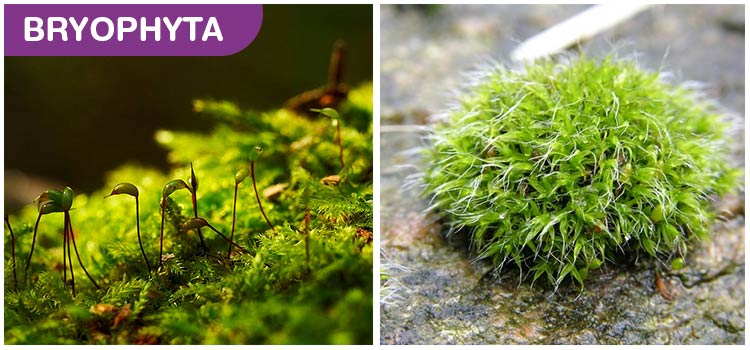
Bryophytes: Small, non-vascular plants that adopt moist environments
Bryophytes do not have vascular tissues. The institute body has root-like, stalk-like and leaf-like structures. Bryophytes are terrestrial plants simply are known every bit "amphibians of the plant kingdom" as they require water for sexual reproduction. They are nowadays in moist and shady places. Bryophyta includes mosses, hornworts and liverworts. Some of the common examples are Marchantia, Funaria, Sphagnum, Antheoceros, etc.
Extended Reading:Bryophyta
Pteridophyta
Pteridophytes have a well-differentiated plant body into root, stalk and leaves. They have a vascular organisation for the conduction of water and other substances. Some of the common examples are Selaginella, Equisetum, Pteris, etc.
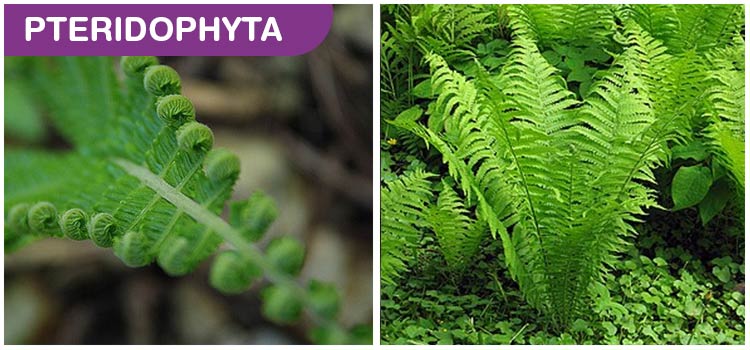
Pteridophytes: Spore-dispersing vascular plants
More than Details: Pteridophyta
Gymnosperms
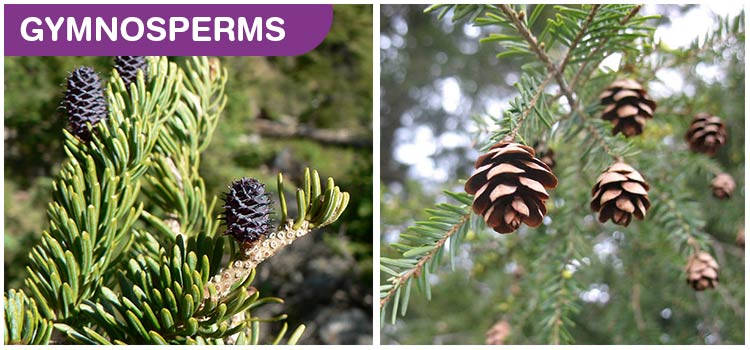
Gymnosperms: Vascular plants that possess "exposed" seeds
Gymnosperms have a well-differentiated plant trunk and vascular tissues. They bear naked seeds, i.east. seeds are not enclosed within a fruit. Some of the common examples of gymnosperms are Cycas, Pinus, Ephedra, etc.
Angiosperms
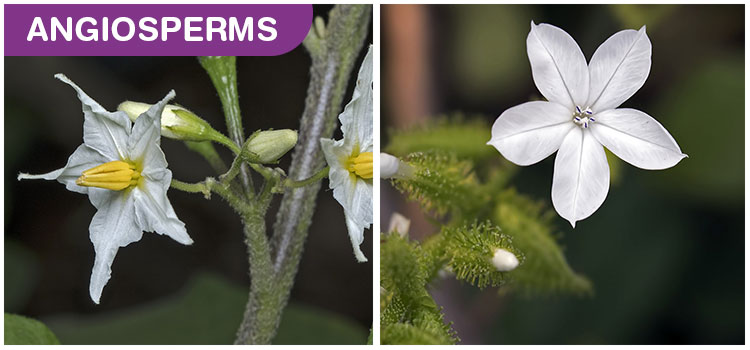
Angiosperms: Vascular plants that possess special characteristics such equally flowers and fruits
Angiosperms are seed-bearing vascular plants with a well-differentiated plant body. The seeds of angiosperms are enclosed inside the fruits. Angiosperms are widely distributed and vary greatly in size, e.1000. Wolffia is small measuring about 0.1 cm and Eucalyptus trees are around 100 1000 tall. Angiosperms are further divided into monocotyledons and dicotyledons co-ordinate to the number of cotyledons present in the seeds. Some of the mutual examples are mango, rose, tomato, onion, wheat, maize, etc.
Further Reading: Angiosperms
Cryptogams and Phanerogams
The plant kingdom is as well classified into two groups:
Cryptogams – Non-flowering and non-seed bearing plants. E.chiliad. Thallophyta, Bryophyta, Pteridophyta
Phanerogams – Flowering and seed-bearing plants. E.g. Gymnosperms, Angiosperms
Also Read:Difference Between Bryophytes and Pteridophytes
To learn more about plant kingdom Class 11, its characteristics and nomenclature, explore BYJU'S biology.
Frequently Asked Questions
Name the pigment responsible for photosynthesis in plants.
Chlorophyll is the paint responsible for photosynthesis in plants.
Draw the criteria for levels of nomenclature in plants.
The institute kingdom is farther classified based on the following three criteria:
- Plant body
- Vascular system
- Seed formation
Explain the characteristic of Thallophytes.
Members of this class lack a well-differentiated torso structure, or in other words, the body is non conspicuously divided into stalk, leaves and roots.
Explain the significant features of Gymnosperms.
Gymnosperms include plants that possess a vascular system and a well-differentiated body structure. Furthermore, they bear seeds like the angiosperms, but they are not encased inside a fruit. Hence, the term "Gymnosperm", which is derived from Greek word, gymno =naked and Sperma =seed.
Listing the characteristics of Angiosperms.
- Seed-bearing plants
- Seeds are enclosed within fruits
- Presence of well-differentiated institute body
- Produce flowers during their lifespan
- Presence of two subtypes – monocots and dicots
Annals at BYJU'S for more plant kingdom notes for reference.
Source: https://byjus.com/biology/plant-kingdom-plantae/
Posted by: millerpithenclacke.blogspot.com

0 Response to "What Is The Main Phyla Or Divisions For Plante In The Animal Kingdom"
Post a Comment